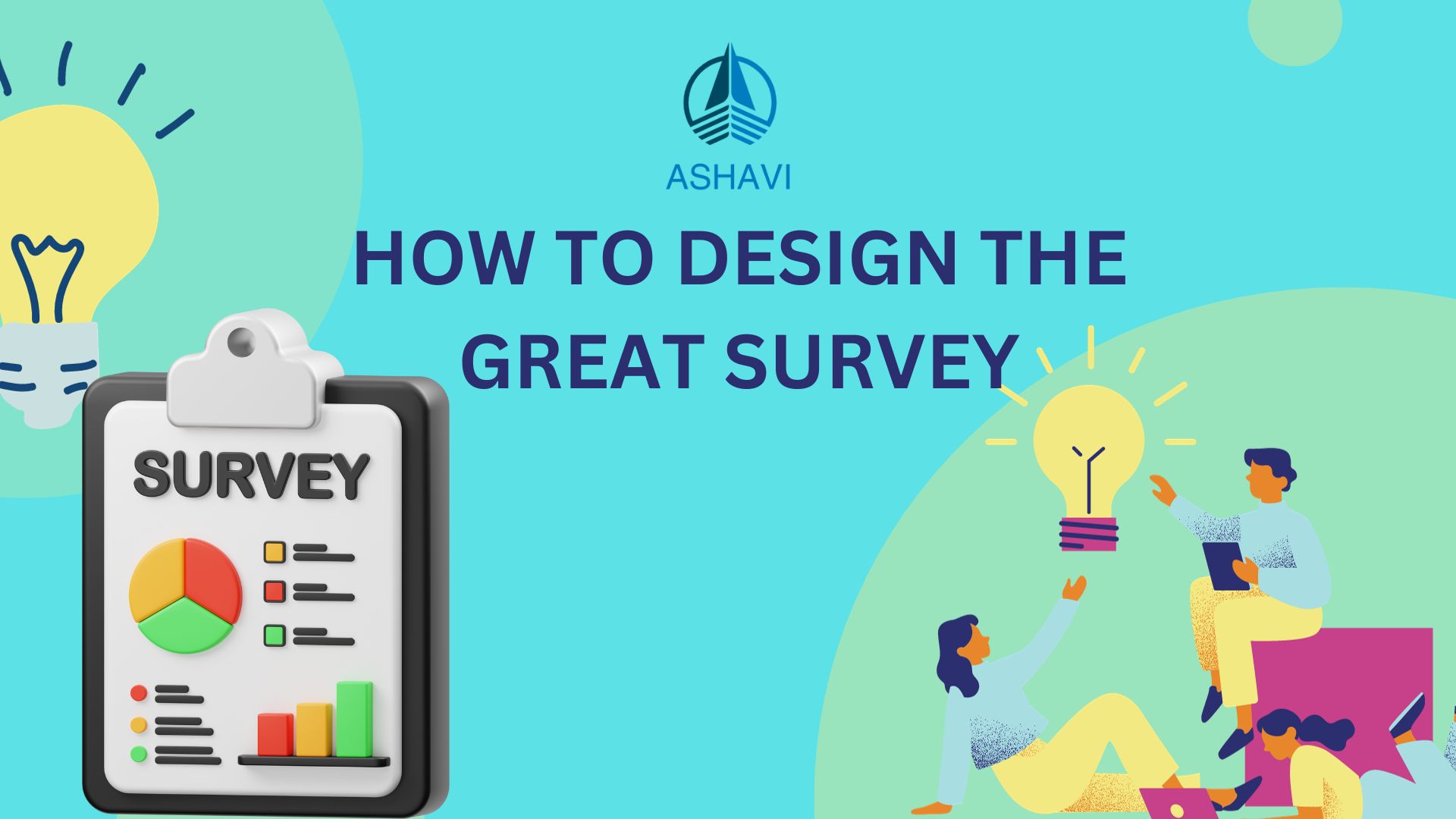

Understand the customers are important, and getting customer insight through survey is one of the main way to know more about your customers. However, there are many barriers which make the survey result are unclear and not really useful for you to take any further decision.
In this article, we would like to share you key points which help you to create the great survey.
1. Set the clear objectives for your survey:
You need to set those questions to yourself: Why are you conducting this survey? What do you want to learn? Who is going to use the survey result? By setting the right and suitable research objectives, you can design the better questionnaire to gain the insight.
Your research objectives shoul be clear, avoid those general terms. Example: If you are the CEO/ Director of the company, and your sales is going down. You want to create the customer survey to understand the reason why your customers are not going to re-purchase your product. You need to set the research objective: - To understand the reason for not re-purchase the product after first purchase. You avoid to set the research objective which is too general such as: Understanding customer experience, understanding customer insight.
Here are some of research objectives which you can reference:
Your research objective should be SMART, and Measurable. The more you set clear objectives, the good direction to go ahead to design the questionnaire.
Those general objectives you should avoid, or if your boss or client are asking you the research objectives which are too general, you can explore deep more levels to gain the SMART research objectives.
Example some general research objectives:
Those research objectives are too general and they can lead to many types of research methodology and lead to too broad project which may impact to cost and time of the company. However, at least you need to have research objectives before doing the research. If it is too general, you can deep dive into it and narrow down to many specific objectives.
.png)
2. Determining your research question
Before starting writing the questionnaire, you need to outline your research questions. Base on the SMART research objectives, you can start thinking about the research questions.
Before starting determining your research question, base on your research objectives, you need to fill in the answers of those questions:
|
1. What is the research result you expect to gain in this questionnaire? / Research outcome |
Write your answer |
End result of research you need to achieve in survey. |
|
2. What are key area of information you want to collect? - Define the primary information (must have) - Define the secondary information (nice to have) |
Write your answer |
Outline the area of information to design the questionnaire. |
|
3. Who do you want to collect this data? / who is your target respondents? |
Write your answer |
This is your target respondents and help you to think about your sample. |
|
4. What are the key indicators? / Data points? |
|
Key indicators or data points measure the outcome you set above. Indicators must be measurable in the framework of your survey. |
You can use mind map to answer question No. 2, this task will help you to outline your research questions by grouping area of information by ranking them on the order of importance.
3. Define the research methodology
Base on the research question in step 2, you need to define which research methodology is suitable to gain those desired information you expected.
In order to achieve research objectives, you might need to combine many methodologies (Primary research with Qualitative / Quantitative, Secondary research, Observation, etc).
Each of methods have different pros and cons, when you understand each methods, you can define the best approach for your research.
Here are some key points about each of methodology:
Observation:
This is basic methodology but it is also important. As a researcher, you should have the eye of sensitivity to know and regconise the issues from observation. This is also quick and easy method to collecting data with minimal efforts. The advantages of observation can be cost-free, effortless. However, in order to gain insight from observation, it is required heavy reliance, expertises from the experts who know clear what to observe and interpret the observations to the data outcome. This method may lead to many biasness as truly depending on one side of the person who observe.
Qualitative Research:
Qualitative research describes research that produces non-numberical results. This method answers the question of “Why” and “How”. This will go deep inside the area and identify all the factors which are the root cause of the result and how do they happen.
Qualitative research is usually applied when you explore the new things, discovery the hidden insight, or explain any issues in deep. By continuing asking Why and How, the researcher can explore more details the valuable the root cause.
Examples of Qualitative Questions:
Qualitative is helping you to list out all the factors, in deep and details. Qualitative won’t help you to understand which factor is most important and represent to the population of your target customers. You need to be careful in taking any decision base on Qualitative result.
Quantitative Research:
The method helps you to quantify the insights, describe the factors with the indicators, numberical results.
The question types which are using for Quantitative Research:
Explore more question types from ASHAVI here. (https://ashavi.com/help/question-types-119.html )
When to use Qualitative and Quantitative Research?
Normally, Qualitative Research is conducted before Quantitative Research, answering the research question of “Why” and “How?”.
Some application cases of Qualitative Research.
Quantitative is conducted to measure the size of something, they can be the size of market needs, the size of customer complains. Quantitative will give you the numberical results, hence most of the time, you should base on Quantitative Research result to take decision.
If Qualitative Research brings you all the factors which impacting to your customers, the Quantitative Research brings you the sense of which factor is the most highest contribution in your customer mind.
Examples:
|
Qualitative |
Quantitative |
|
Question: Why do you like working remotely? |
Question: Below are all the factors about working remotely, which one is the most important for you? |
|
Answer: - Flexibility - Saving time in commuting to work - Family Orientation - Work life balance |
Answer: After asking 100 persons, you have the data here: - 50% Flexibilty - 20% saving time in commuting to work - 10% Family Orientation - 20% Work Life Balance |
4. Write your questionnaire
The structure of questionnaire normally will include those 3 parts:
Part 1: Demographic question, profile question: Age, Gender, Education Level, Occupation Level, Lifestyle, Living conditions, Location, etc.
This part will help you to have the basic sense of your respondents and key input for further analysis.
Part 2: Main questionnaire:
Here is the part where you will write down all the questions to address the research information which you have outline above. You should write your questionnaire with the logic / sequence of questionnaire such as Customer Journey starts from demand, research, trial, purchase, after purchase, or Brand Health Track, you should ask from Brand Awareness, Brand Consideration, Brand Trial, Brand Purchase, Brand Usage, Brand Experience, Brand Loyalty. Or you can use the time sequece to ask from past to current, from current to future. The logic sequence would give the respondents into the contect which is easy to imagine and answer correctly.
Some important notes:
Part 3: Sub-question and Thank you Note
The last part of questionnaire should be some sub-questions you want to explore more and thank you note. For sub-question, you can ask or simple ignore this part. But if your questionnaire is short, we recommend to ask 2-3 more sub-questions to help you understand more contact details, lifestyle and habit of your customers. Those questions might not irrelevant to your research, but somehow, it will help you to understand more about your customers, you might need it in future.
Example of sub questions:
Lastly, the questionnaire should have thank you note. You should write down formal thank you note to your respondents to show your respect and appriciation to their time spending on your survey. This is also helping you to engage your respondents to the future research.
It is very important to pilot the questionnaire before launching it. During the pilot, you can identify more areas which are non-approximate and fix it before launching it.
5. Define the sample size and sample collection methodology:
Ideally, one survey should gather data of at least 80% up to 100% total population so that the result would be fair enough to bring the reliable result. However, in the reality, it’s difficult to conduct the survey with large sample size. We recommend that if your total population size is less than 1,000, you should conduct the survey at least 40% of size, which means 400 samples. If your population size more than 1,000, you can use tool to calculate the minimum sample size required to conduct the survey.
In most of the cases, the researchers don’t have enough of resource to reach all samples, the researchers need to carefully identify the subset of sample which is represetative of the larger population. By doing this correctly, the survey data will be useful to draw inferences.
Top 3 important things in choosing the sample population:
How to choose the sampling technique?
Probability sampling: Probability sampling is a statistical technique used to select a random sample of individuals from a population, in order to study that population.
Non Probability sampling: Non probability sampling is a type of sampling where units are not selected randomly from the population. This means that some units will have a greater chance of being selected than others. The four most common types of non-probability samples are convenience samples, quota samples, snowball samples, and judgment samples. A method of selection in which the chances of choosing a particular unit are unknown or unknowable.
Minimize sampling error
What is a sampling error? A sampling error refers to a discrepancy in data retrieval. It can be either due to random errors, systematic bias, or both. When conducting a study, sampling errors can happen when the sample used is not representative of the population. In order to reduce sampling error, researchers calculate margins of error during final results as a statistical practice. The margin of error is the amount of error allowed for a miscalculation to represent the difference between the sample and actual population.
What are the most common sampling errors in market research?
Market research is essential, but it can be tricky. Here are the top four common errors while sampling:
How to minimize sampling error:
ASHAVI is the online research platform which helps the researchers to design the survey questionnaire, gain the reponses and analyse survey result in the quick and easy way.
Try ASHAVI today to gain your consumer insight.